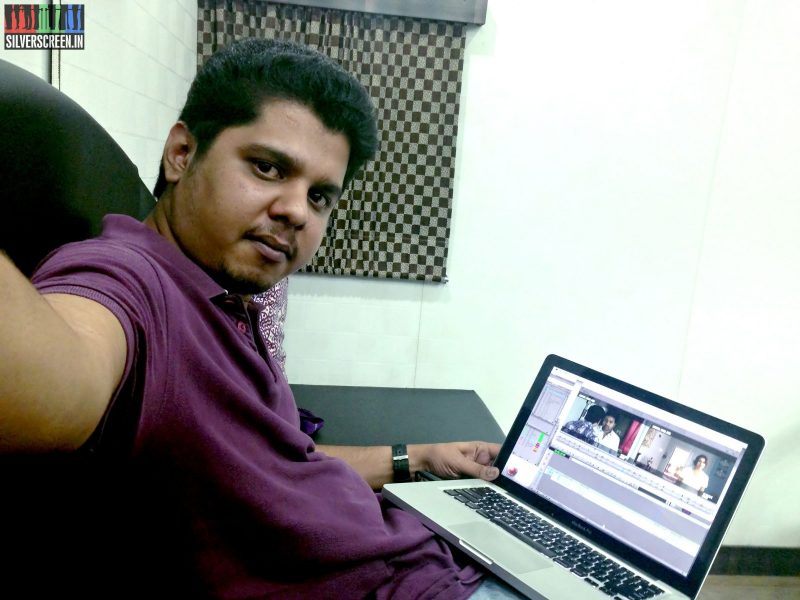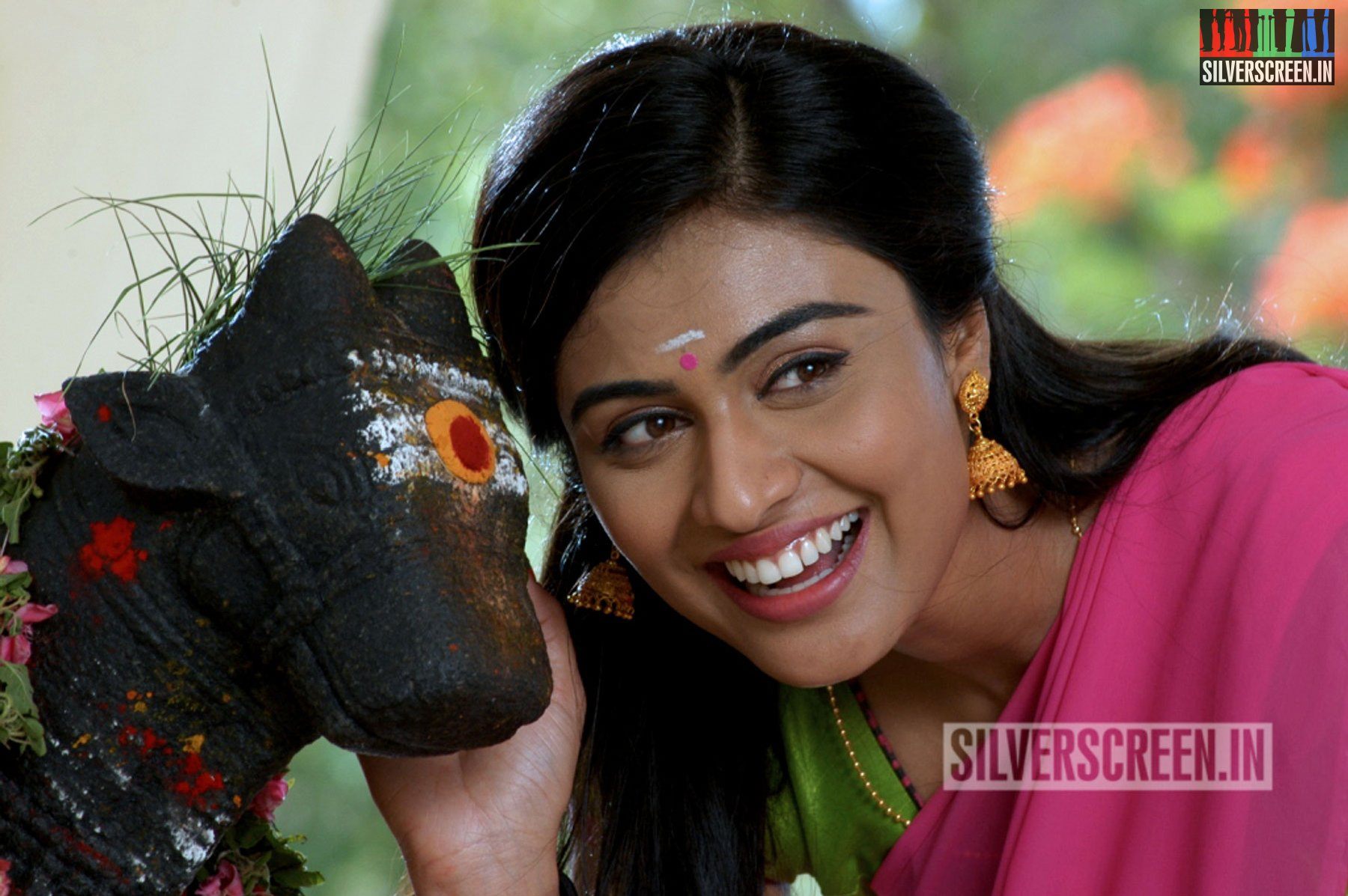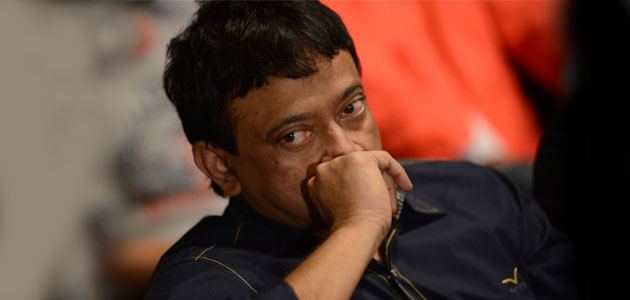March 2015 was a mixed month for editors in Tamil cinema. Vivek Harshan won a National Award for his stylish editing in Jigarthanda. Another – TE Kishore – tragically lost his life after a brain haemorrhage. And the two events loom large over my conversation with editor TS Suresh, even if we spend very little time talking about them. Suresh, who has a marked penchant for quirky movies, talks about both events with an odd mixture of pride and anguish.
He has begun taking care of himself in earnest, for one. He doesn’t skip his breakfast these days, “after what happened to Kishore”, and later, lists out with a flourish, the number of National Awards that Tamil cinema editors have been honoured with in the past few years.
Also, he begins his day with a comedy sequence. Santhanam or Vivek. You really don’t want to ruin your mornings by editing emotional routines, he says. His work influences him powerfully. “I would begin thinking about past relationships…you never know.”
Sequences involving death too, are saved for later.
After lunch, perhaps?
*****
Suresh’s office is nothing unconventional. Tables, chairs and computers. Except there is an elephant in the room. One that he is willing to acknowledge.
It makes for beautiful wallpaper on his 42 inch screen. Probably shot in the Savannah, the elephant occupies a significant portion of the picture while a giraffe (or is that a deer?) – grazing further away, is a little out of the frame. Aesthetically pleasing camerawork.
“Director Priyadarshan taught me composition,” Suresh says, “For instance, look at that picture. There’s a tree in the background, and a lot of space in the front. I learnt to pay attention to such detailing.” Suresh had worked with Priyadarshan on the Mohanlal-starrers, Oru Marubhoomikkadha and Geethanjali. “He would also tell me not to repeat shots. He would say, ‘I am okay with lengthy shots, but don’t repeat them with a lot of cuts. It has to be different every time.’”
*****
“I wanted to direct movies. But I didn’t know where to begin. That’s when I met my friend’s father – director Agathiyan. He advised me to choose something technical because of the longer run value. Also because, it is less risky.”
*****
Suresh’s childhood was spent in Vellore, amidst touring talkies, a mother who was a big fan of director Shankar, and a lot of Rajini and Kamal. “I still remember the time when Kadhalan hit theatres in 1994. My mother, who would always watch Shankar movies on the first day, took me along for the show.”
There isn’t anything spectacular about this episode except, “I was writing my quarterly exams then,” grins Suresh, “but my mother spoke to the correspondent, and he agreed.”
It probably helped that Suresh was just graduating from primary school then. Who can pit 6th grade tests against Shankar, anyway?
But the fascination for cinema began there, he says.
*****
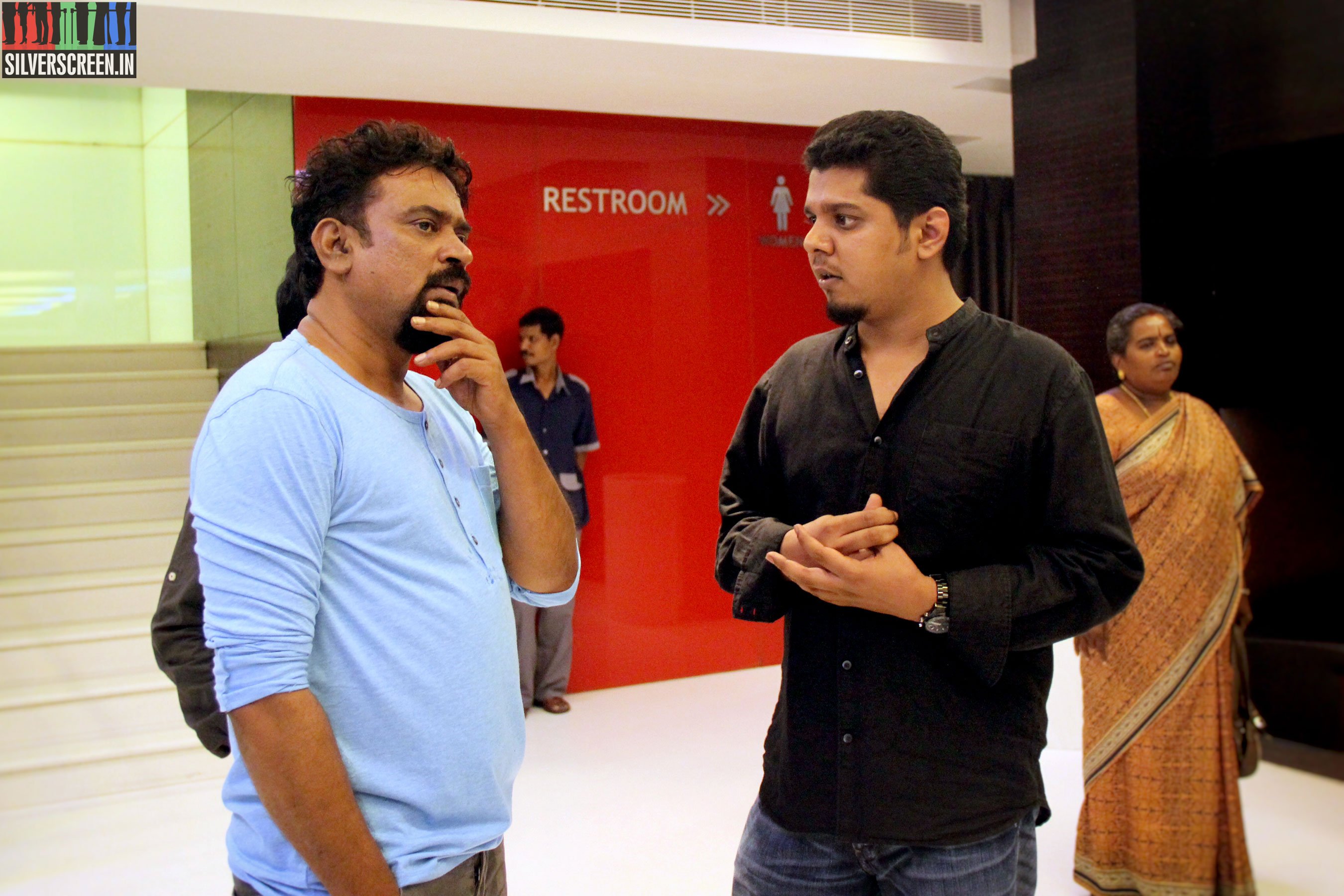 A degree in Visual Communications at SRM, apart from introducing him to celluloid, also helped him forge connections. “I was good at computers, had a lot of interest in the arts, but it was this particular telefilm that I made in college that sparked an interest in editing.”
A degree in Visual Communications at SRM, apart from introducing him to celluloid, also helped him forge connections. “I was good at computers, had a lot of interest in the arts, but it was this particular telefilm that I made in college that sparked an interest in editing.”
Because, Suresh says, “it was very bad”.
“My professor edited the film, and made it look good. That was perhaps the first spark.”
Several workshops, and a meeting with Madhusudhanan – the Visual Effects Supervisor for many Hollywood movies like Spiderman and The Lord of the Rings, and also the upcoming Uttama Villain and Viswaroopam 2 – later, Suresh was convinced. While his desired apprenticeship with editor Sreekar Prasad did not happen, he had an equally impressive alternative.
Suresh would frequent editor Anthony’s studio after college every day, and assisted him on several famous projects between 2005 and 2009. Especially the ones with Gautham Menon at the helm. Vettaiyaadu Vilaiyaadu and Kaakha Kaakha are the movies that figure prominently in our conversation. “When Anthony sir and Gautham Menon work together, the sensibilities in the film are similar to that of Hollywood,” observes Suresh. “There would be healthy discussions; in fact, it was Anthony who suggested that Kaakha Kaakha begin with Suriya’s memories. That scene was initially intended as pre-climax. Anthony said being linear won’t work always. So, we took to showing montages in the form of Suriya’s thoughts.”
https://www.youtube.com/watch?v=ovj-5iM9wMY
*****
Suresh’s elder brother teaches drawing. That’s another reason why he was so interested in art. And, Inam, with Santhosh Sivan for director, is the movie that had him pleased; there was ample potential to explore. “I was told to do whatever I wanted to,” he declares, “Sivan would tell me, ‘if it feels right, go ahead.’ Generally, directors would want to retain all visually appealing shots, but here, I was told to ‘forget the beautiful’.” It already is pleasing to the eye, the emotions must be prominent here, not the visuals – was Santhosh Sivan’s clear directive. “Vishal (Chandrasekhar) would compose music, and I would edit scenes to fit his tunes. It was more like jamming, an independent project. Also, Sivan would pay us quite well.”
It was one of those projects where he’d forget himself.
“No lunch, nothing.”
*****
Thamizh Padam – released in 2010 – proved to be a great debut, both for director CS Amudhan, and editor TS Suresh. “Actually Amudhan didn’t want a fresher to edit his film because he was a debutant director himself,” reveals Suresh, “but Dhayanidhi Alagiri and Sushanth convinced him to meet me. I was given three scenes to edit. The spoof of Sivaji, Vaidehi Kaathirundhaal, and one more – he was happy with what I did, and I was on board.”
Whatever Suresh does, he declares, a little proudly, it will always have the “touch of Anthony”. His jump cuts, the way he cuts songs, the way he begins and ends a scene, are all influenced by Anthony’s work.
For Thamizh Padam though, he had to unlearn things a little. It was a demanding project, one that relied heavily on editing. “Fortunately, I didn’t have to do much. Amudhan had it all down on paper. The only thing I was explicitly told was to go with the pace of the film.” The movie was a spoof of various other Tamil films, “so when editing the footage of Thalapathi for instance, I had to hold the shot a little longer, make sure I didn’t cut fast.” Otherwise though, Amudhan was relaxed about all else, editing grammar included.
“During the Bharatanatyam scene, Shiva would be in and out of the frame. When an artiste goes out of the frame, the shot would be removed. But Amudhan wanted it there. He said it’s a spoof, and we don’t really have to follow rules.”
Thamizh Padam was particularly challenging – especially for a debutant editor – because it consisted of a series of footages strung together by a common thread. “We were connecting different films, and I was clueless about how it was going to be received,” recalls Suresh, “only when the audience clapped at the 4th minute, I knew we were safe.”
*****
A recent movie had something interesting to say about the general perception of editing, and the vagaries of an editor’s life. An early scene in Kallapadam featured a couple – a film editor and his fiancée – out for coffee. When the woman learns that he’s not an actor after all, she calls off the relationship. She also likens his work to that of a tailor’s. “Many think editing is just assembling shots,” Suresh grumbles, “It is not. I actually go to the dubbing studio and get to know what modulations I would need, and also insist on listening to sound transitions. I design sound, too.”
Sometimes, Suresh’s work begins very early in a movie, while with others, he is called on much later. But the preference, largely, is to be included right when the movie is conceptualised. “I am in talks for a Hindi film now. The director approached me after shooting for 50 days. With Amudhan though, he usually calls me as soon as he has an idea. We research individually, and then, along with the rest of the team, we sit in pre-production. We are all fans of Raaja sir, so there’s singing and jamming as well.”
For Irumbu Kuthirai – the Priya Anand and Atharvaa starrer – Suresh went to Italy, and was a part of the shoot. “They would film during the day, and I would edit at night. So if I needed a patchwork or an insert, I would tell them immediately.”
*****
“You cannot lie to a doctor, or a lawyer. And, you cannot lie to an editor, too,” Suresh suggests; he’s only half-joking. “When a scene hasn’t been done well, I expect directors to be open with me. That way, I can try salvaging it.”
His work is a little tedious, yes, for most films that come to the table would never have scenes in order. “My assistant would sit and align the shots in chronological order, and then, we would begin work.”
But that’s how it is, says Suresh. Because, not all artistes would be available on the same date. “I was assisting Anthony sir during Vettaiyaadu Vilaiyaadu, and a particular scene required the presence of both Kamal and Jyothika. But they shot for it separately – six months apart, in fact – and it was later assembled at the editing table. In the final cut, they’re in the same shot, talking.”
“Also, sometimes, the director would have shot the same scene from different angles, so we would have four options for a particular scene, and have to decide what works at the editing table.”
That way, Suresh was quite impressed with director Balaji Mohan, whose debut movie – Kadhalil Sodhappuvadhu Eppadi – he was a part of. “The movie was in perfect editing order,” reveals Suresh, “all I had to do was cut after ‘action’, and then again when the director says ‘cut’. It was like editing Priyadarshan’s films, the only other director whose movies are in editing order.”
“Perhaps because,” Suresh reasons, “Balaji Mohan was an editor himself before he became a director.”
*****
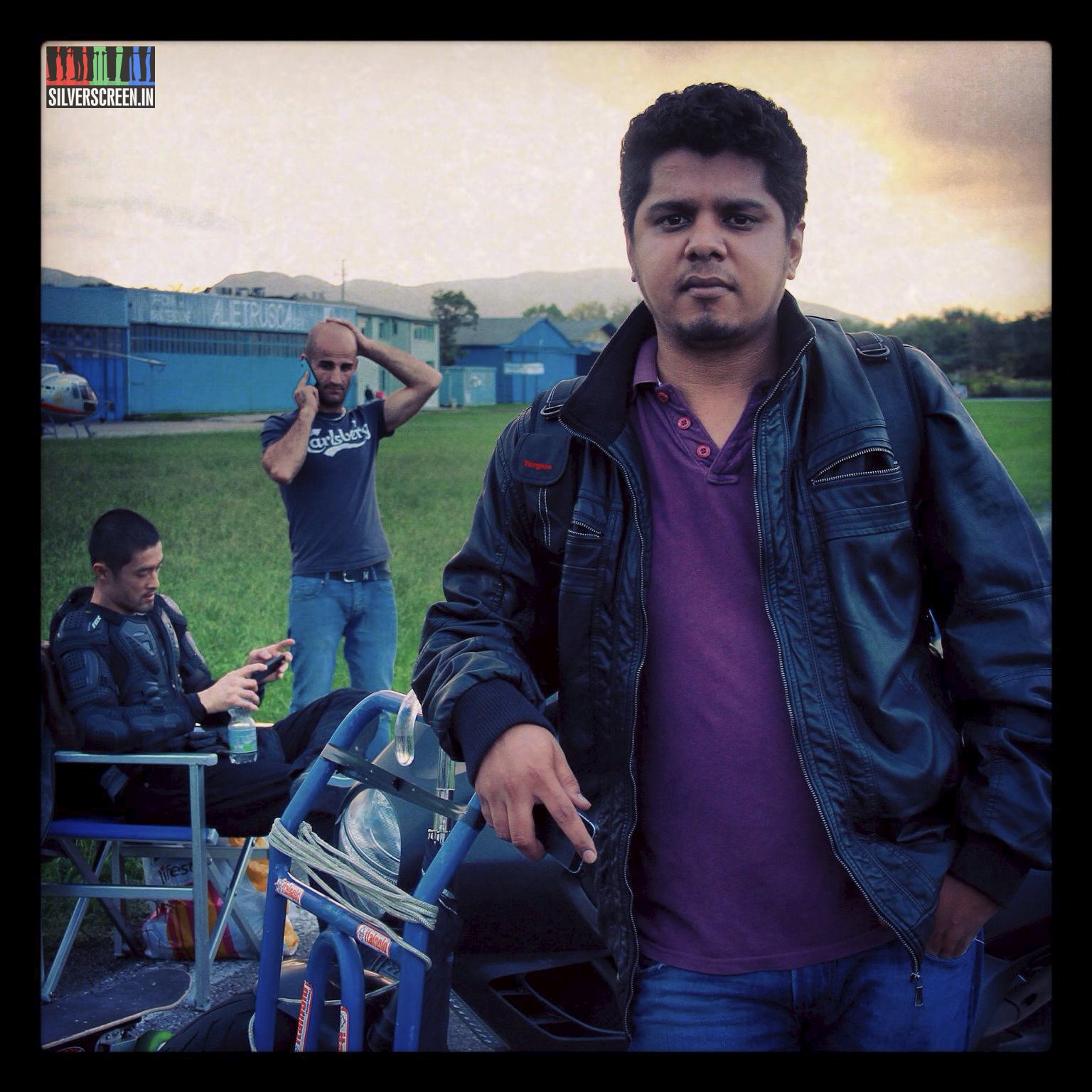 Every project, Suresh says, had something new to offer: a few lessons here and there. If Santhosh Sivan taught him the nuances of editing arthouse films (and also to read and paint), Amudhan would want him to come up with “something new” every time. “He used to work on ad films earlier, so he would want something never seen before.” Kiruthiga Udhayanidhi, on the other hand, doesn’t like “fast cuts”. “Working with a woman filmmaker, I learnt a lot. She wanted smooth edits for Vanakkam Chennai. Didn’t like harsh cuts or effects. She was also big on emotions, and at the same time, wanted the visuals simple and sleek.”
Every project, Suresh says, had something new to offer: a few lessons here and there. If Santhosh Sivan taught him the nuances of editing arthouse films (and also to read and paint), Amudhan would want him to come up with “something new” every time. “He used to work on ad films earlier, so he would want something never seen before.” Kiruthiga Udhayanidhi, on the other hand, doesn’t like “fast cuts”. “Working with a woman filmmaker, I learnt a lot. She wanted smooth edits for Vanakkam Chennai. Didn’t like harsh cuts or effects. She was also big on emotions, and at the same time, wanted the visuals simple and sleek.”
There’s a reason why some director prefer women editors, Suresh says. Thelma Schoonmaker for Martin Scorsese, Aarthi Bajaj, who still continues editing Anurag Kashyap’s movies even after their divorce, and Renu Saluja, who had edited Kamal Haasan’s Hey Ram among other movies. “You need a woman’s perspective on things. For instance, with Vanakkam Chennai, Kiruthiga was very particular about what she wanted. As soon as the test shoot was over, I knew I was going to work with someone good. She shot only what was needed. She would tell me, ‘I want my women to be prominent, so give them enough space.’ ”
Suersh is also currently working with director Anjana, on her movie, Pallandu Vaazhga. “She is someone who gives importance to female characters. I would be given some background about the character, and she would ask me to keep that in mind while cutting.
And, I usually edit 10 scenes a day, but Anjana and I decided to do just two scenes. We wanted to have a lot of time to discuss.”
*****
“If you hold a shot for a long time, you feel it. It is as simple as that,” Suresh shrugs. It’s more like hypnotism, he says. “When you stare at a person for a while, you can read them. In Taare Zameen Par, they hold shots centered around the child for a long time. It makes you feel for him. That’s what editors do, they enhance emotions.”
https://www.youtube.com/watch?v=_xgza0cMYJw
But the scenes involving emotions are difficult to edit, too. “With action, you can cut it to the punch, but with this, time and space are really important.”
He had a taste of it while working on Thamizh Padam. “I was keen on trimming the village portions and a few jokes. But Amudhan said I have to give them some time. I didn’t find the scenes funny, but the whole theatre was laughing when it released. I learnt a lot.”
*****
Quite often, sounds and sound effects are added at the editing table too – borrowed from the editor’s library of stock music – when the director doesn’t find anything suitable. “I use Yuvan Shankar Raja’s background score when I want to arouse emotion. I have used his score in over 25 films, it can liven up any shot.” Tracks from 7G Rainbow Colony and Kadhal Kondein are Suresh’s favourites. “Even when I was assisting Anthony, we would use a lot of reference music. Passion of the Christ and Troy are great for emotions, too, and for a chase sequence, something from The Fast and The Furious and 300 would do. They are intense pieces of music.”
Hans Zimmer’s tunes, Suresh adds, are a constant refrain, whether in the movies he edits, or as soothing music while he works.
*****
Suresh hails from a Marathi Brahmin family. And this, he says, helps him understand Hindi when he works on Bollywood projects. Kannada comes easy too, for his mother is a Kannadiga.
Telugu, with its similar-sounding words, and thick accent, is what he finds difficult. “You cannot guess the meaning of a phrase at all. Malayalam has traces of Tamil, so I am okay with it. But for Telugu movies, I have to do a lot of homework, hang out with my Telugu friends, and observe how they talk, so that I know where to begin and end a dialogue.”
He edited Love Failure – the Telugu version of Kadhalil Sodhappuvadhu Eppadi, and has worked on another film – Okkosaari – which is yet to release.
Understanding the cultural context of the region is quite important, Suresh says. “In Hindi, there is a script supervisor. Sometimes, they would tell me I am seeing things from a Tamil perspective. For instance, during Rangrezz – the remake of Nadodigal, I felt scenes similar to the Tamil version won’t work here. Then, I was told not to judge the Hindi audience based on Bombay. They were talking about audiences in Bihar, UP, MP and Gujarat where life is still slow, and not as frenzied as Bombay.”
*****
Influences for Suresh come from everywhere. Sreekar Prasad to Lenin, Michael Kahn to Thelma Schoonmaker, he borrows a little from all of them. “Lenin is known for his sharp cuts,” Suresh explains, “he will hit you so hard. In Mouna Ragam, Karthik stops his bike in front of the bus with Revathi and tries to convince her to admit that she likes him. Revathi asks him to, ‘come back tomorrow’. Then, a bus passes. That is supposed to indicate the passage of time, and we now see the next shot. Lenin took away a whole day with a neat, sharp transition. I like doing things like that.”
https://www.youtube.com/watch?feature=player_detailpage&v=pUGxi0ZpXGI#t=150
Inam was a tribute to Sreekar Prasad, Suresh says, because Santhosh Sivan usually works with him. “He is known for his poetic cuts. In Terrorist, the lead characters begin their journey inside the forest. Prasad then cuts to a leaf falling from a tree, and sinking into the bottom of a river. In the next scene, they’ve reached their destination. Sreekar Prasad uses a lot of lovely metaphors.”
“With Anthony sir, there’s style, especially with the way he cuts songs and trailers. There is a process called final trimming, where we cut the pause between dialogues in a conversation. I learnt that from him. Anthony is also great at montages, where different, seemingly unrelated shots are strung together, and set to music. Pachai Kiligal from Indian, Chinna Chinna Aasai etc are great examples. I take inspiration from them.”
*****
A typical Suresh cut? He grins at the question. “I am glad. Editing must be invisible, as long as it goes unnoticed, I am happy.”
*****
Suresh entered the industry when he was 18. “I had no care in the world,” he laughs, “I think 18 is the right time to come in. Everything would be new to you, and you would want to explore. Anthony sir would yell at me because I would experiment a lot. Now though, I am more cautious.”
Yes, he has used splicers – by way of perfunctory training – but they had long gone out of fashion when he began work. Like editors the world over, Suresh uses Avid now. “I have seen the transition though,” he offers, “I have seen both the old and the new. The editing union has a rule that you must know the beginning and end of a negative …only then do you get a membership.”
*****
Suresh watches a movie at least a 100 times before it releases. “100 or sometimes, even more,” he says. “I have to make sure there is nothing amiss. I actually know the dialogues by heart. I can recite them before the release.”
Of course, there are times when he gets annoyed. Especially when he has watched a scene for the 50th time. “I take a break, then. Or put on some music. Peppy ones like Yaakai Thiri and Taxi Taxi.”
*****
Spielberg, Scorsese, Tarantino and Nolan are some of his favourite directors. “You know, I had no idea who Mani Ratnam was when I was 10. Back then, it was all Bharathiraja, Balachander and Bhagyaraj.” Now though, he likens Spielberg to Rajinikanth. “There’s just nobody like him, is there?”
*****
“Editing has become more mature now – five National Awards for editors in Tamil cinema during the past few years; but yes, I do get requests from directors now and then to make a song like Suttum Vizhi Sudare – I would tell them that’s already been done, we have to think of something else. The problem is, many directors think I can create something new – I can only enhance what is already there.”
He has a rule of thumb when it comes to choosing movies: a healthy mix of commercial and arthouse. “Commercial for bread and butter, and art films for the creative push. In Hollywood, editors commit only to one film at a time. But here, the pay isn’t great. We get only a few lakhs for a movie, or sometimes, even less. That’s why I generally take up three films.”
*****
Suresh is a little tremulous when addressing his original plan: that of becoming a director. “It’s not an easy task, you know. I had, in fact, discussed something with Sivan, and he said this is the right age to begin. But, I still have a lot to learn.”
Recommended
His upcoming movies include Amudhan’s Rendaavadhu Padam, STR’s Vaalu, Nayanthara’s Maya, Pallandu Vaazhga, directed by Anjana, Okkosari in Telugu, and an English independent film, helmed by a “director from Delhi.”
*****
“I have become health conscious, now,” Suresh offers just as we wrap up. “Kishore’s death was a sharp reminder. I finish work by 7 pm, and take breaks, too. That way, I am happy that this isn’t a 9-5 job. It’s one of those liberties that you can enjoy in a creative setup.”
*****
The TS Suresh interview is a Silverscreen exclusive.
